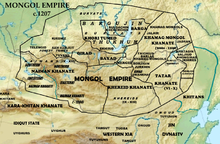
Back Onqutlar Azerbaijani Ongut Catalan اونگوت Persian Öngüt French オングト Japanese Онгуд Mongolian Onggud Dutch Öngüter NB Onguci Polish Онгуты Russian

The Ongud (also spelled Ongut or Öngüt; Mongolian: Онгуд, Онход; Chinese: 汪古, Wanggu; from Old Turkic öng "desolate, uninhabited; desert" plus güt "class marker"[1]) were a Turkic tribe that later became Mongolized[2][3] active in what is now Inner Mongolia in northern China around the time of Genghis Khan (1162–1227).[4] Many Ongud were members of the Church of the East.[5] They lived in an area lining the Great Wall in the northern part of the Ordos Plateau and territories to the northeast of it.[4] They appear to have had two capitals, a northern one at the ruin known as Olon Süme and another a bit to the south at a place called Koshang or Dongsheng.[6] They acted as wardens of the marches for the Jin dynasty (1115–1234) to the north of Shanxi.[7]
- ^ Rybatzki, Volker. (2004) "Nestorian Personal Names from Central Asia" in Verbum et Calamus. Semitic and related studies in honour of Professor Tapani Harviainen. Studia Orientalia 99. p. 271
- ^ Cite error: The named reference
Aristovwas invoked but never defined (see the help page). - ^ Cite error: The named reference
Ochirwas invoked but never defined (see the help page). - ^ a b Roux, p.40
- ^ Phillips, p. 123
- ^ Halbertsma, Tjalling H. F. (2008). Early Christian Remains of Inner Mongolia: Discovery, Reconstruction and Appropriation. Brill. pp. 150–157. ISBN 978-90-04-16708-7.
- ^ Saunders, John Joseph (2001). The History of the Mongol Conquests. University of Pennsylvania Press. p. 52. ISBN 0-8122-1766-7.
© MMXXIII Rich X Search. We shall prevail. All rights reserved. Rich X Search